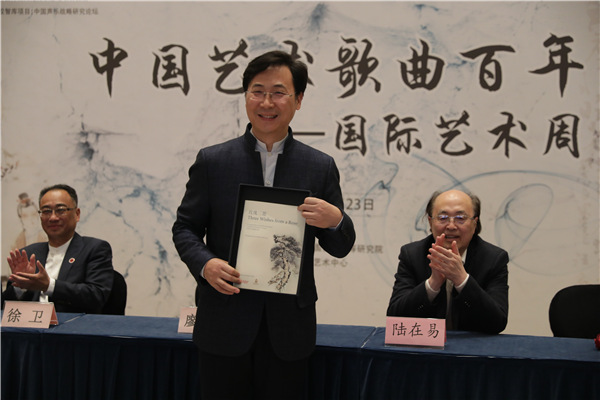 |
|
Liao Changyong (center), head of the Shanghai Conservatory of Music, introduces a series of publications that celebrate 100 years of Chinese art songs on Nov 23. [Photo provided to China Daily] |
The Shanghai Conservatory of Music and German publishing house Breitkopf & Hartel jointly launched Sixteen Chinese Art Songs on Nov 23.
The publication, an international-standard music book featuring 16 Chinese art songs with lyrics of ancient Chinese poems, will help to introduce Chinese art songs to artists and singers in other countries, enabling them to perform the songs, with a better understanding of the music and diction, according to Liao Changyong, head of the SHCM.
Breitkopf & Hartel, nicknamed Big Bear, is the oldest music publishing house in the world. It is of great value to Breitkopf & Hartel to publish the 16 Chinese art songs with poetry from a thousand years ago set to music by composers in the 20th century, says Hartmut Holl, a scholar of art songs of Germany and Austria. Holl was impressed with the powerful energy and rich emotions of these songs, even though he could not understand Mandarin, upon hearing a recital of Liao, an internationally recognized baritone singer.
This year marks the centennial celebration of the birth of art songs in China. The Shanghai Conservatory of Music, as an important center of the research of these music creations, kicked off a series of projects as early as 10 years ago.
On Nov 23, the SHCM also announced the publication of three volumes of The Collection of Chinese Art Songs 1920-1949 by the SHCM Press. The collection consists of 110 songs, from The River Runs East, created in 1920 by Qing Zhu (the pen name of Liao Shangguo), which marked the birth of Chinese art song, to a combination of Chinese classical poetry and Western composing techniques, according to Liao Changyong.
The collection marked the first overall in-depth research and systematic review of the development of art songs in China. While the music scores provide adequate guiding for the performers, the introduction of works with their respective period, content and style will help to further understand and analyze the art songs of China.
An award-winning singer, Liao Changyong says "we used to sing German and Austrian operas, and songs by classical composers from the West … I believe all of that were preparations for us Chinese to interpret our own culture".
In 2019, Liao Changyong toured four cities in Europe performing 16 Chinese art songs with traditional poetry for lyrics. Calligraphy and Chinese paintings featuring the poems were presented in the hall. The recitals were so successful that "we had planned this year to tour more than 10 cities if not for the outbreak of COVID-19", Liao Changyong told the media on Nov 23. "We are very proud to share the beauty of Chinese culture with international audiences and happy to find them loving it and ready to embrace it."